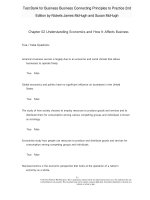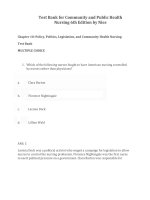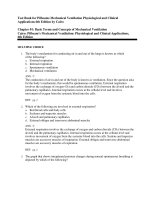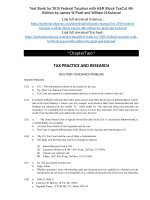Download PDF test bank for new ebersole and hess toward healthy aging 9th edition by touhy
Bạn đang xem bản rút gọn của tài liệu. Xem và tải ngay bản đầy đủ của tài liệu tại đây (264.23 KB, 10 trang )
Test Bank for New Ebersole and Hess Toward Healthy Aging 9th
Edition by Touhy
Sample
Chapter 11: Vision
MULTIPLE CHOICE
1. You have four rooms to choose from for your older client to be admitted
this afternoon. Which room would you choose?
a.
A brightly lit, blue room with cozy throw rugs
b.
An orange-carpeted room with soft lighting and
yellow walls
c.
A brightly lit, blue room with an EZ-Glide wax floor
d.
A fluorescent-lighted room with green walls and a glossy,
tiled floor
ANS: B
Light colors such as red, orange, and yellow are more easily seen by aging eyes. Softer
lighting will help reduce some of the glare and is also easier seen by aging eyes. Fidelity
of color is less accurate with the blues, greens, and violets of the spectrum, and the
slowed ability of the pupils to adjust to light makes glare a problem. Glare can come
from sunlight, but a brightly waxed floor and glossy tile can also cause glare.
DIF: Cognitive Level: Applying
REF: p. 138
TOP: Integrated Process: Teaching/Learning
MSC: Client Needs: Health Promotion and Maintenance
2. An older adult client shares with the nurse that, “I don’t know what it is but
it seems that I need more light for reading or even watching television as I
get older.” The nurse explains that aging may cause this change due to the:
a.
slower ability of the pupil to adjust to changes in lighting.
b.
impact arcus senilis has on visual acuity
c.
flattening and thinning of the cornea.
d.
retinal changes that begin to occur with aging.
ANS: A
A slowed ability of the pupil to accommodate to changes in light accounts for the need of
this patient to have more light in order to read. Arcus senilis does not affect vision. It is
true that the cornea becomes flatter and thinner with aging, which results in astigmatism.
Astigmatism does not account for the need for increased light that this patient is
reporting. The changes in the retina do not account for the need for increased light that
this patient is reporting.
DIF: Cognitive Level: Applying
REF: p. 131
TOP: Integrated Process: Teaching/Learning
MSC: Client Needs: Health Promotion and Maintenance
3. A 77-year-old client being treated for glaucoma asks the nurse what
causes glaucoma. The nurse’s response is:
a.
the exact etiology of glaucoma is variable and often
unknown.
b.
spasms of the orbicular muscle.
c.
changes to the suspensory ligaments, ciliary muscles,
and parasympathetic nerves.
d.
bits of broken coalesced vitreous from the peripheral or
central part of the retina.
ANS: A
The etiology of glaucoma is variable and often unknown. However, when the natural
fluids of the eye are blocked by ciliary muscle rigidity and the buildup of pressure,
damage to the optic nerve occurs. Spasms of the orbicular muscle can cause the lower
lid to turn inward. If it stays this way, it is called entropion. The changes described
contribute to decreased accommodation. Bits of coalesced vitreous that have broken off
from the peripheral or central part of the retina is the definition of floaters.
DIF: Cognitive Level: Remembering
REF: p. 134
TOP: Integrated Process: Teaching/Learning
MSC: Client Needs: Health Promotion and Maintenance
4. An older man tells a nurse, “The doctor says I have something wrong with my
eyes, something called presbyopia. Can you explain why I have this? I was
always fortunate to have good eyesight.” The nurse formulates a response based
on the knowledge that:
a.
the lens of the eye loses elasticity causing a loss of focus
for near objects.
b.
the cornea of the eye becomes thicker and less curved
causing an increase in astigmatism.
c.
the lens of the eye increases in opacity causing a
decrease in light refraction.
d.
the cornea of the eye forms a gray ring at the edges.
ANS: A
Presbyopia is the loss of focus for near objects, caused by a loss of elasticity and hence
a loss of accommodation of the lens of the eye. All of the other options are normal agerelated changes; however, they are not related to presbyopia.
DIF: Cognitive Level: Applying
REF: p. 132, Table 11-1
TOP: Integrated Process: Teaching/Learning
MSC: Client Needs: Health Promotion and Maintenance
5. An older resident in a long-term care facility reports to the nurse that she has
been noticing changes in her vision, including the appearance of halos around
objects and a yellow tint to most objects. The nurse knows that these complaints
are most often associated with:
a.
cataracts.
b.
glaucoma.
c.
diabetic retinopathy.
d.
age-related macular degeneration.
ANS: A
Signs of cataracts include the appearance of halos around objects as light is diffused,
blurring, decreased perception of light and color giving a yellow tint to most objects, and
a sensitivity to glare.
DIF: Cognitive Level: Remembering
REF: p. 134
TOP: Integrated Process: Teaching/Learning
MSC: Client Needs: Health Promotion and Maintenance
6. An older patient reports the following symptoms to a nurse during a routine visit to
the geriatric clinic: blurry vision, the need for more light when reading, and
blind spots in the middle of his visual field. He also states, “Strangely enough my
peripheral vision continues to be pretty good.” The nurse suspects that the patient
has which of the following?
a.
Glaucoma
b.
Age related macular degeneration
c.
Diabetic retinopathy
d.
Cataracts
ANS: B
Blurry vision, needing more light, and blind spots in the middle of the visual field
(scotomas) are all characteristics of age related macular degeneration. The other three eye
diseases do not present with these symptoms.
DIF: Cognitive Level: Applying
REF: pp. 135–136
TOP: Integrated Process: Teaching/Learning
MSC: Client Needs: Health Promotion and Maintenance
MULTIPLE RESPONSE
1. A nurse is providing glaucoma education for a group of older adults in a senior
center. The nurse knows that the following groups are most likely to develop
glaucoma. (Select all that apply.)
a.
African Americans
b.
Mexican Americans
c.
Individuals with a family history of glaucoma
d.
Individuals with diabetes
e.
Asian Americans
ANS: A, B, C, D
African Americans are at risk of developing glaucoma at an earlier age than other racial and
ethnic groups. Mexican Americans, individuals with a family history of glaucoma, and
individuals with diabetes are among the other high-risk groups. Asian Americans are more
likely to lose eyesight from age-related macular degeneration than other groups.
DIF: Cognitive Level: Remembering
REF: p. 133
TOP: Integrated Process: Teaching/Learning
MSC: Client Needs: Health Promotion and Maintenance
2. A nurse is performing preoperative teaching for an older adult who is scheduled
to have a cataract extraction and lens implant. The nurse includes which of the
following in the teaching plan? (Select all that apply.)
a.
Avoid lifting heavy objects after the surgery
b.
Avoid bending from the waist after the surgery
c.
Take stool softeners as needed
d.
Maintain strict control of your blood sugar and blood
pressure
e.
Maintain a dry sterile dressing over the eye for 10 days
ANS: A, B, C
Postcataract surgery the individual needs to avoid heavy lifting, straining, and bending
from the waist. Fall prevention is also very important as is complying with eye drop
administration. Maintaining strict blood sugar and blood pressure control is most
important for diabetic retinopathy, not cataract extraction. There usually is not a dressing
over the operative site, and not for 10 days.
DIF: Cognitive Level: Applying
REF: pp. 134–135
TOP: Integrated Process: Teaching/Learning
MSC: Client Needs: Health Promotion and Maintenance
3. An older patient is diagnosed with diabetic retinopathy. The patient asks a nurse:
“Is there anything that I can do to prevent progression of this disease and
blindness?” The nurse includes which of the following into the response? (Select
all that apply.)
a.
Strict control of blood glucose levels is important in
slowing disease progression
b.
Laser photocoagulation treatments can stop progression
of the disease
c.
Control of blood pressure and cholesterol levels
are important steps slowing disease progression
d.
Wearing sunglasses to protect the eyes from
ultraviolet light can stop disease progression
e.
Eating a diet high in beta-carotene can stop disease
progression
ANS: A, B, C
Constant strict control of blood pressure, blood glucose, and cholesterol and laser
photocoagulation treatments can halt progression of the disease. Laser treatment can
reduce vision loss in 50% of patients. Neither protecting the eyes from ultraviolet light
nor eating a diet high in beta-carotene has been proven to be effective in stopping disease
progression.
DIF: Cognitive Level: Applying
REF: p. 136
TOP: Integrated Process: Teaching/Learning
MSC: Client Needs: Health Promotion and Maintenance
4. A nurse is conducting an assessment of an older patient’s eyes. The nurse
expects to see which of the following normal age-related changes of the external
eye? (Select all that apply.)
a.
The eyelids are less elastic and droopy
b.
The eyes are very dry
c.
The eyelids may not close completely
d.
There is a loss of eyelashes
e.
The lower lid may be turned outward
ANS: A, B, C, E
Normal age-related changes in the external eye include a loss of elasticity causing
drooping. Eyes become drier, and the eyelids may not close completely. Decreases in
orbital muscle strength may result in entropion, the outward turning of the lower lid. Loss
of eyelashes is not a normal age-related change.
DIF: Cognitive Level: Remembering
REF: p. 132, Table 11-1
TOP: Integrated Process: Teaching/Learning
MSC: Client Needs: Health Promotion and Maintenance
New Ebersole and Hess Toward Healthy Aging: 9th Edition Test Bank – Touhy









